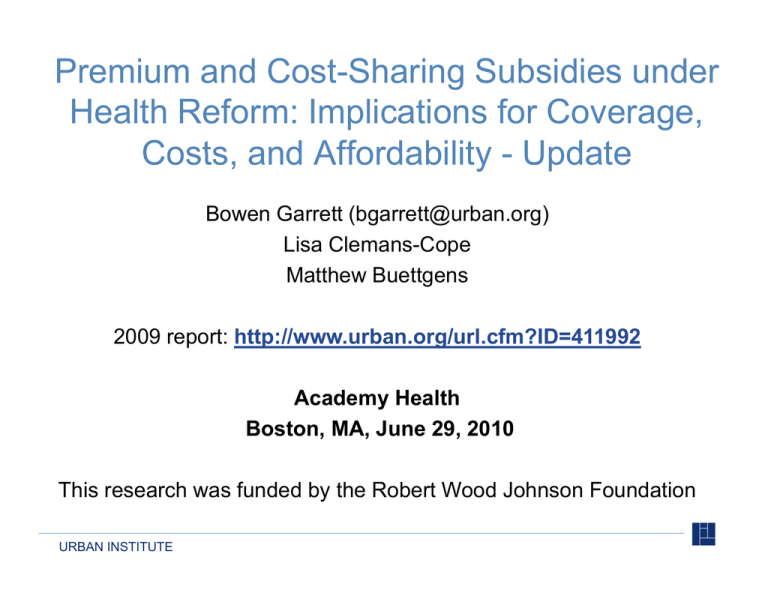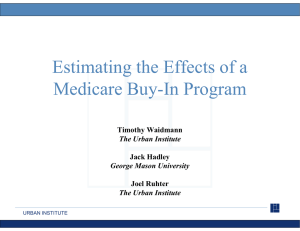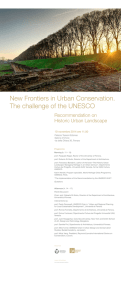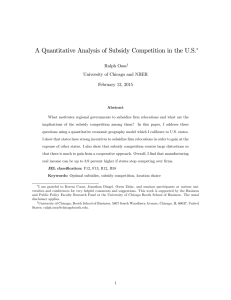Premium and Cost-Sharing Subsidies under Premium and Cost Sharing Subsidies under
advertisement

Premium and Cost Cost-Sharing Sharing Subsidies under Health Reform: Implications for Coverage, Costs and Affordability - Update Costs, Bowen Garrett (bgarrett@urban.org) ( g @ g) Lisa Clemans-Cope Matthew Buettgens 2009 report: http://www.urban.org/url.cfm?ID=411992 Academy Health Boston, MA, June 29, 2010 This research was funded by the Robert Wood Johnson Foundation URBAN INSTITUTE Research Questions • What are the coverage, cost, and affordability implications of the premium and cost-sharing subsidies in the Affordable Care Act (ACA)? –B Benefits fit off providing idi affordable ff d bl options ti mustt be b balanced against costs to government –G Greater affordability ff d bili iincreases compliance li with i h the h individual mandate – High compliance is needed for broad risk pools • What if subsidies were further enhanced? URBAN INSTITUTE Will Premium and Cost-Sharing g Subsidies be Adequate? • Burdens for some families can be high under ACA – e.g., 20% or more • States could enhance federal subsidies with their own funds • Fed or states could target further subsidies to reduce financial burdens of premiums and cost cost-sharing sharing for specific groups URBAN INSTITUTE Maax premium as % % of inco ome Premium Subsidy Levels 9.5% 10.0% 9.5% 9.5% 8.05% 9.0% 8.0% 8.0% 6.3% 7.0% 6 0% 6.0% 5.0% 4.0% 4.0% 3.0% 3.0% 2.0% 1.0% 0.0% 100% 0.0% 150% 200% 250% 300% 350% Income as a % of FPL ACA URBAN INSTITUTE Enhanced 400% Acctuarial vvalues w with subsidy Cost-Sharing Subsidy Levels Result in these Actuarial Values 100% 9 % 95% 90% 85% 80% 75% 70% 65% 100% 150% 200% 250% 300% 350% Income as a % of FPL ACA Law ACA Law Enhanced URBAN INSTITUTE 400% Health Insurance Policy Simulation Model (HIPSM) • Detailed microsimulation model of the health care system • Estimates the cost and coverage effects of proposed h lth care policy health li options ti • Developed by researchers at the Urban Institute, a nonprofit nonpartisan policy research organization nonprofit, • Predecessor model used to provide a roadmap for the 2006 legislation in Massachusetts • Recent work modeled reform options for New York, national reform options, and gave technical assistance to officials of the Obama administration URBAN INSTITUTE HIPSM Simulates Coverage Decisions of Employers, Families, and Individuals • Uses CPS matched with several national data sets • Simulates state Medicaid eligibility and enrollment • Adjusts Adj for f CPS Medicaid M di id undercount d • “Synthetic” firms simulate the preferences of employees l • Premiums for employer and non-group health insurance risk pools are computed iteratively based on medical expenses, administrative load, and subsidies URBAN INSTITUTE Behavioral Effects in HIPSM • Utility-based y approach pp – Individuals choose the available option that provides them the highest utility – Firms offer based on preference of median worker – The utility-based approach can better estimate effects of reforms that are well outside historical experience • Total utility = Specified utility + Latent utility (error term) • Key to HIPSM’s mechanics are the imputed error terms that: – Ensure baseline coverage is optimal – Yield premium elasticity and take-up rates consistent with assumed targets URBAN INSTITUTE In HIPSM, HIPSM Dollar Dollar-Valued Valued Specified Utility for Each Coverage Option Depends on • Expected out-of-pocket health care expenses • Variance of out-of-pocket health care expenses • Value of health care consumed • Out-of-pocket premiums • Tax incentives • Expected out-of-pocket expenses / income URBAN INSTITUTE What is modeled here? • The major j coverage g p provisions of the Affordable Care Act – Medicaid expansion to 133% FPL – Premium rating rules – ESI and nongroup exchanges – Premium and cost-sharing subsidies – Small group tax credits – Employer assessments – Individual mandate • As if fully implemented in 2010; single year estimates URBAN INSTITUTE Nu umber of Nonelderlyy Estimated Reduction in Uninsured Due to ACA 60m 50.0 50m 40 40m 30m 20m 21.1 10m 0m Remaining uninsured g (in millions) All figures preliminary URBAN INSTITUTE Baseline ACA Effects of ACA on Health Insurance Coverage 300m Nu umber of N Nonelderly 250m 200m 150m 50.0 21.1 8.7 Uninsured 87 8.7 60.4 Other (incl Medicare) 43.1 14 8 14.8 Medicaid/Public 41 6 41.6 12.4 100m 151.3 50m 123.6 Exchange Nongroup (Excl g ) Exchange) Employer (Excl Exchange) All fi figures preliminary li i 0m URBAN INSTITUTE Baseline ACA Effects of ACA on Health Care Spending $120b $100b $ Billions $80b $ $60b Aggregate Change in Spending $53.8 Billion $ $11.7 $8.6 Household $34.5 Employer Uncompensated Care $40b $20b $0b $50.2 ‐$14.3 ‐$20b ‐$40b Exchange Subsidies g Medicaid/Public ‐$36.9 ACA URBAN INSTITUTE Other Net Govt All figures preliminary Enhanced Subsidies Would Further R d Reduce N Number b off U Uninsured, i d M Modestly d tl Nu umber o of Nonelderly 60m 50.0 Baseline 50m 40m 30m 20m 21 1 21.1 19.7 ACA 10 10m 0m Remaining uninsured (in millions) URBAN INSTITUTE All figures preliminary Enhanced Subsidies N Number of None elderly Enhanced Subsidies Would Increase Nongroup Enrollment in Exchange 45m 40m 35m 30m 25m 20m 0m 15m 10m 5 5m 0m URBAN INSTITUTE 41.6m 42.7m 15.2 16.6 26.4 26.1 ACA C Enhanced h d Subsidies All figures preliminary Exchange g Nongroup Exchange Employer Enhanced Subsidies Would Raise Overall Costs Somewhat $120b Aggregate Change in Spending $53.8 $55.8 Medicaid/Public $100b $80b $50.9 $50.2 Employer $ Billlions $60b $5.0 $8.6 $40b $34.5 $45.1 $11.7 ‐$14.3 $14 3 $8.6 ‐$14.4 $14 4 Exchange Subsidies Exchange Subsidies ‐$36.9 ‐$39.4 Household Other Net Gvt $20b $0b Uncompensated Care ‐$20b ‐$40b ‐$60b ACA URBAN INSTITUTE Enhanced Subsidies All figures preliminary He ealth Care Costs a as Percent of Inccome Median Health Care Cost Burdens for Nongroup Exchange Coverage 30% 25% ACA 20% 14.1%13.8% 15% 10.3% 10% 10.9%11.1% 300– 399% FPL 400– 499% 500% FPL or FPL more 6.8% 6.3% 5% 11.1% 9.7% 2.8% 0% 133– 199% FPL URBAN INSTITUTE 200– 299% FPL All figures preliminary Enhanced Subsidies He ealth Carre Costs a as a Perccent of In ncome 90th Percentile Health Care Cost Burdens for g p Exchange g Coverage g Nongroup 30% 24.3% 24.0% 25% 10% 20.6% 20.5% 19.2% 20% 15% ACA 22.4% 21.3% 14.9% Enhanced Subsidies 14.4% 8.0% 5% 0% 133– 199% FPL URBAN INSTITUTE 200– 299% FPL 300– 399% FPL 400– 499% FPL All figures preliminary 500% FPL or more Summary y and Discussion • Premium and cost-sharing subsidies under ACA will make coverage affordable for millions • Health care cost burdens will remain high for many, esp middle income families with esp. ith high medical need • Enhanced premium subsidies would – Raise coverage a modest amount (1.4m) relative to subsidy cost ($10.6b) – Substantially S b t ti ll reduce d fifinancial i lb burdens d off ttargeted t d groups • Affordability likely to drive public support for reforms URBAN INSTITUTE Extra Slides URBAN INSTITUTE The Nongroup g p Exchange: g Median Health Care Costs $25 000 $25,000 $20,000 ACA $15,000 13,618 13,598 9,272 9,281 $10,000 6,117 $5 000 $5,000 5,375 3 675 3,675 1,325 2,497 575 $0 133– 199% FPL URBAN INSTITUTE 200– 299% FPL 300– 399% FPL 400– 499% 500% FPL or FPL more Enhanced Subsidies The Nongroup g p Exchange: g 90th Percentile of Health Care Costs URBAN INSTITUTE


